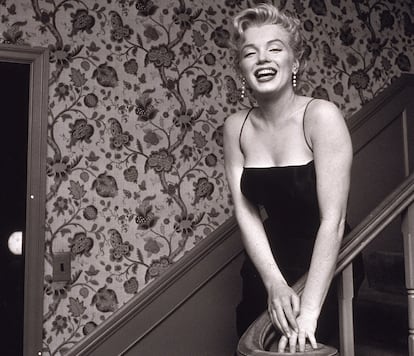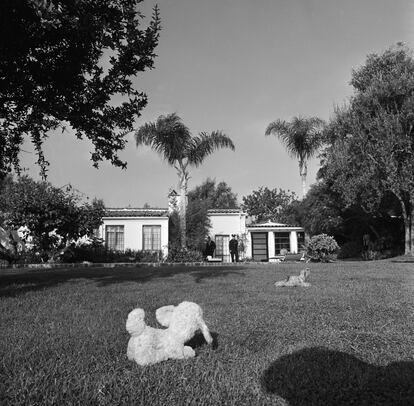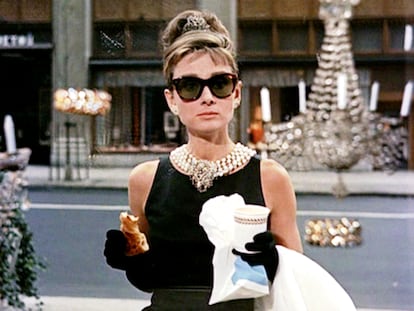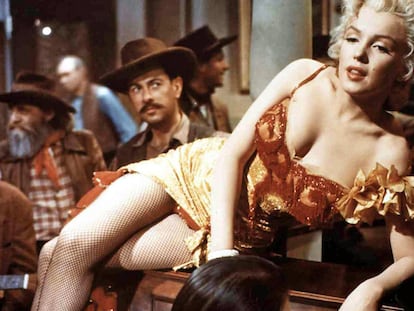The decline of Hollywood’s golden age: Marilyn Monroe’s house slated for demolition
The colonial-style property that the actress bought in Los Angeles in 1962, the only home she ever owned, is not protected by the city’s landmarks regulations


Marilyn Monroe experienced many things in her life. Different lives, even. In her 36 years, she married three times, worked in 30 films, was photographed thousands of times, gave hundreds of interviews, attended countless parties and premieres, and became one of the biggest stars in the Hollywood firmament. However, she only ever owned one house, which she bought aged 35 as an unparalleled global superstar. She chose it herself, and had started to decorate it herself, although when she died a year later everything remained half-finished. It is a historic place, to which fans continue to flock six decades after she passed, but that is now on the verge of disappearing as its new owners intend to demolish it.
12305 5th Helena Drive is a relatively small construction for Los Angeles. It is a classic, simple house, far from the style of the mansions of today’s movie stars. Located in the Brentwood neighborhood, south of the city, near the mountains but not far from the beaches of the Pacific, it was built in 1929 in the colonial or Mexican style, as it is called in California, with low white-walled buildings with patios and terracotta floors. Monroe bought in early 1962, after living in the Hollywood Hills with Joe DiMaggio and in the popular Runyon Canyon area, much sought after by celebrities, with Arthur Miller. But this was her first and only home, with four bedrooms, three bathrooms, wood-beamed ceilings, a pool that she apparently never used, bougainvillea and an orchard of citrus trees, and in whose master bedroom she was found dead of an overdose on August 4 of that same year.
The actress paid around $77,500 dollars at the time, which with inflation would be almost $760,000 dollars today. In March 1963, Gilbert and Betty J. Nunez bought it and many of Monroe’s belongings it still contained for $87,500, which they auctioned off in the late 1990s. The estate was sold in 2017 to the owner of an investment fund named Dan Lukas and his wife, Anne Jarmain. They sold it in August to new owners.

From that point, versions differ. According to the Los Angeles Times, Lukas and Jarmain are still the owners and those who are thinking of demolishing it, although the couple do not speak to the press. However, luxury-lifestyle magazine Robb Report states the couple purchased another house in the same area of Brentwood six months ago for $13 million and sold 12305 Fifth Helena Drive for about $8.4 million a month ago to new owners who intend to pull down the existing structures and build something bigger and more modern.
In any case, its owners have requested a demolition permit from the city authorities. In principle, a simple formality. Since the mid-1960s, Los Angeles has operated a landmark and building preservation program that groups together more than 1,200 historic sites either because they have hosted important events, due to their architecture, or because of their significance. They range from churches, libraries, and hotels to houses designed by famous architects, from fire stations to cemeteries and movie studios (such as those of Charles Chaplin) and inclusion on the list implies full protection. There are around 50 in the Brentwood area, but Monroe’s house is not among them.
The actress’s home has never been among the buildings that sought this protected status, but a 2013 assessment by the city identified it as “potentially significant for its association with Marilyn Monroe,” but that “more research was needed in this regard.”
EL PAÍS contacted with the Department of City Planning of Los Angeles, which said: “The city undertook a comprehensive survey over the last several years to identify potentially historic properties. The property was identified in 2013 through the survey as being potentially significant for its association with Marilyn Monroe.” The agency shared a report which gives an account of the assessment conducted in June 2013 and which explains that the property has indeed been linked to the entertainment industry and also that, because the house cannot be fully viewed from the street, the assessment cannot be finalized. “The property was not designated [as historic] at that time. In most cases, a nomination to designate a property historic is submitted by an interested party and not initiated by the city. The city is investigating whether or not a nomination could proceed, at this point, given the pending building permits,” they added.

The Brentwood Homeowners Association (BHA), founded in 1946 by volunteers, watches over the heritage of the neighborhood, and has filed a complaint so that the property is not lost, like so many other remnants of Hollywood’s golden age that have been swallowed up by the city. Rodney Liber, a former film producer and resident of the area for 30 years, is a member of the BHA’s board of directors and, as he explains by e-mail, “a fan of Marilyn Monroe.” “The Brentwood Homeowners Association and many of its members are very saddened by the looming demolition of the house, especially since it is one of the most famous homes in the world,” he says. “However, the BHA has no power or jurisdiction to intercede, since there are no rules about getting permits from the city and the house is not on its list of historic properties. We had hoped that the current owners would have bought it to preserve it, but because of the value of the land they may have changed their minds.”
Brentwood is a quiet neighborhood, although there are always a handful of tourists hanging around Monroe’s house. It was a place she cherished, somewhere of her own. In fact, a few weeks before she died, she gave a long interview to Life magazine where, even with the boxes half unpacked, she talked about the excitement of owning it (“And it has walls.” she said) and the handicrafts she had bought on a trip to Mexico to decorate it. She also explained why she did not want them to be featured in the report. “I don’t want everybody to see exactly where I live, what my sofa or my fireplace looks like,” she said. Next to the main house was a small building, an apartment, for which she already had a use in mind: “A place for any friends of mine who are in some kind of trouble, you know, and maybe they’ll want to live here where they won’t be bothered till things are OK for them.” That little house no longer exists: in one of the renovations, it was attached to the main house as an extension. What is apparently still standing is the Latin inscription that can be read inscribed on the tiles of the front porch: Cursum Perficio: Here ends my journey.
Sign up for our weekly newsletter to get more English-language news coverage from EL PAÍS USA Edition
Tu suscripción se está usando en otro dispositivo
¿Quieres añadir otro usuario a tu suscripción?
Si continúas leyendo en este dispositivo, no se podrá leer en el otro.
FlechaTu suscripción se está usando en otro dispositivo y solo puedes acceder a EL PAÍS desde un dispositivo a la vez.
Si quieres compartir tu cuenta, cambia tu suscripción a la modalidad Premium, así podrás añadir otro usuario. Cada uno accederá con su propia cuenta de email, lo que os permitirá personalizar vuestra experiencia en EL PAÍS.
¿Tienes una suscripción de empresa? Accede aquí para contratar más cuentas.
En el caso de no saber quién está usando tu cuenta, te recomendamos cambiar tu contraseña aquí.
Si decides continuar compartiendo tu cuenta, este mensaje se mostrará en tu dispositivo y en el de la otra persona que está usando tu cuenta de forma indefinida, afectando a tu experiencia de lectura. Puedes consultar aquí los términos y condiciones de la suscripción digital.
More information
Archived In
Últimas noticias
Most viewed
- Sinaloa Cartel war is taking its toll on Los Chapitos
- Oona Chaplin: ‘I told James Cameron that I was living in a treehouse and starting a permaculture project with a friend’
- Reinhard Genzel, Nobel laureate in physics: ‘One-minute videos will never give you the truth’
- Why the price of coffee has skyrocketed: from Brazilian plantations to specialty coffee houses
- Silver prices are going crazy: This is what’s fueling the rally










































